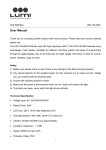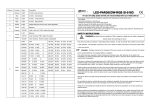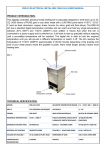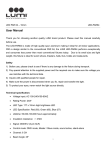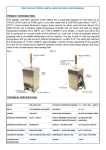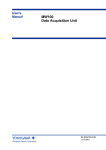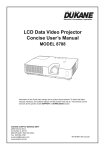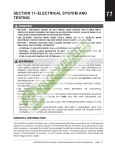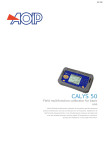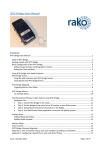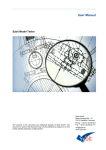Download Global Buyers Store Global Buyers Store Global Buyers Store
Transcript
DIGITAL PANEL METER GLOBAL BUYERS STORE Instruction YOUR BEST ONLINE STORE Manual G G lob G lob al G lob al Bu G lob al Bu ye G lob al Bu ye rs G lob al Bu ye rs St G lob al Bu ye rs St ore G lob al Bu ye rs St ore G lob al Bu ye rs St ore G lob al Bu ye rs St ore G lob al Bu ye rs St ore lo a B y rs S or ba l B uy er S to e l B uy er s S to re uy er s S to re er s S to re s to re St r or e e Thank you for purchasing our product ! One-Year Limited Warranty Globalbuyersstore warrants your newly purchased product against defects in material and workmanship existing at the time of manufacture for a period of one years from the date of purchase. Warranty Registration is not necessary to obtain the applicable warranty on the product. The date of purchase will be used to determine the warranty period when warranty service is requested. It is important to read the Setup Guide before installing or commissioning this instrument as it contains important information relating to safety and EMC. Please verify the panel cutout dimensions and mount according to instructions. SAFETY CONSIDERATIONS Unpacking and Inspection Your instrument has been carefully tested and inspected prior to shipment. Unpack the instrument and inspect for obvious shipping damage. Please do not attempt to install or operate the unit if damage is found. This instrument is a panel mount device protected in accordance with Class I of EN 61010. Installation of this instrument should be done by Qualified personnel. In order to ensure safe operation, the following instructions should be followed. This instrument has no power-on switch; it will be in operation as soon as power is connected. Do not make signal wiring changes or connections when power is applied to the instrument. Make signal connections before power is applied and, if reconnection is required, disconnect the power before such wiring is attempted. Do not connect more than one meter to the same power supply if the meters cannot use the same signal ground. Do not exceed voltage rating stated on the specifications. Always disconnect power before changing signal and power connections. Do not use this instrument on a work bench without its case for safety reasons. Do not operate this instrument in flammable or explosive atmospheres. Do not expose this instrument to rain or moisture. Whenever EMC is an issue, always use shielded cables. Instrument which will not be installed immediately should be stored in a clean, dry location. WARNING: The use of this instrument in a manner other than specified may impair the protection of the instrument and subject the user to hazard. Careful use of the instrument will provide years of reliable service. Please consult your licensed electrician/electrical engineer for professional advice before installation. At the end of its life cycle, dispose of this product in accordance with local and national disposal regulations. The information contained in this document is believed to be correct but we accept no liability for any errors it may contain, and reserve the right to alter specifications without notice. Copyright © 2006-2012 Globalbuyersstore Digital World. All Rights Reserved. This document may not be copied,photocopied, reproduced, translated, or reduced to any electronic medium or machine-readable form, inwhole or in part, without our prior written permission. Copyright © 2006-2012 www.globalbuyersstore.com e-mail : [email protected] P. 1/6 GLOBALBUYERSSTORE - 1/16 DIN PID Digital Temperature Controller INSTRUCTION MANUAL G G lob G lob al G lob al Bu G lob al Bu ye G lob al Bu ye rs G lob al Bu ye rs St G lob al Bu ye rs St ore G lob al Bu ye rs St ore G lob al Bu ye rs St ore G lob al Bu ye rs St ore G lob al Bu ye rs St ore lo a B y rs S or ba l B uy er S to e l B uy er s S to re uy er s S to re er s S to re s to re St r or e e Version 3 .2 3. Front Panel and Operation Caution This controller is intended to control equipment under normal operating conditions. If failure or malfunction of it could lead to an abnormal operating condition that could cause personal injury or damage to the equipment or other property, other devices (limit or safety controls) or systems (alarm or supervisory) intended to warn of or protect against failure or malfunction of the controller must be incorporated into and maintained as part of the control system. ⑥ ① ⑦ ⑤ ④ ③ ② 1. Features Figure 1. Front panel The PID control with artificial intelligent enhancement for precision temperature control. Auto-tuning function can find the best PID parameter automatically. On/off control mode for refrigerator, motor and solenoid valve control application. Bumpless transfer between Auto and Manual control. Limit control for safety protection and special applications. The output can be set for SSR output control or relay contactor control by the user. Two contact relays can be configured as one PID and one alarm output, dual alarm outputs, or dual On/off control. Support 10 different types of commonly used temperature sensor inputs. ① AL1 Relay J1 output indicator AL2 Relay J2 output indicator AT- On for manual mode. Blinking during auto-tuning process OUT- SSR output indicator ② Value increment/Select next parameter ③ Value decrement/Select previous parameter ④ Auto tuning/Digit shift ⑤ Set/Confirm/Manual Auto switching/Reset (for Limit control mode) ⑥ Measured temperature, or, Process Value (PV) ⑦ Set temperature, or, Set Value (SV) 4. Terminal Wiring (back view) + SSR - TC RTD + - W 2. Specification 6 Thermocouple (TC): K, E, S, R, J, T, B, WRe3/25 RTD(Resistance temperature detector): Pt100, Cu50 Input type Input range See table 2 Display Dual lines, four digits, °F or °C Display resolution 1°C, 1°F; or 0.1°C, 0.1°F with Pt100 Accuracy ±0.2% or ±1 unit of full input range Control mode PID, On-off. Limit, Manual Output mode Relay contact: 3A at 250VAC, SSR: 8VDC, 30 mA. Alarm Process high/low alarm Power consumption <2 Watt Power supply 85-265V DC or 85-265V AC/50~60Hz Sample rate 4 samples/sec Operating condition 0 ~ 50 °C, ≤85% RH Mounting cutout 45 x 45 mm Dimension 48x48x75mm (1/16 DIN) 7 9 11 13 12 14 2 1 + 8 R 3 R 10 4 J2 NO 5 - com NO J1 COM = Common, always connect to this, it is the moving part of the relay's switch. NC = Normally Closed, COM is connected to this when the relay coil is off. NO = Normally Open, COM is connected to this when the relay coil is on. Power NC 85-265V Figure 2. Wiring diagram 4.1 Sensor connection 4.1.1 Thermocouple The thermocouple should be connected to terminals 9 and 10. Make sure that polarity is correct. There are two commonly used color codes for the K type thermocouple. US color code uses yellow (positive) and red (negative). Imported DIN color code uses red (positive) and green/blue (negative). The temperature reading will decrease as temperature increases if the connection is reversed. Copyright © 2006-2012 www.globalbuyersstore.com e-mail : [email protected] P. 2/6 GLOBALBUYERSSTORE Parameter Display Operation Mode SET Enter Code SET SET XXXX Input Sensor Selection SET XXXX inty 0089 SET Output mode selection SET X outy G G lob G lob al G lob al Bu G lob al Bu ye G lob al Bu ye rs G lob al Bu ye rs St G lob al Bu ye rs St ore G lob al Bu ye rs St ore G lob al Bu ye rs St ore G lob al Bu ye rs St ore G lob al Bu ye rs St ore lo a B y rs S or ba l B uy er S to e l B uy er s S to re uy er s S to re er s S to re s to re St r or e e 4.1.2 RTD sensor For a three-wire RTD with standard DIN color code, the two red wires should be connected to the terminals 9 and 10. The white wire should be connected to terminal 8. For a two-wire RTD, the wires should be connected to terminals 8 and 9. Jump a wire between terminals 9 and 10. Set controller input type, Inty, to P100 (1° resolution) or P10.0 (0.1° resolution). 4.2 Power to the controller The DC power cables should be connected to terminals 1 and 2. Terminal 1 is positive and 2 is negative. When connecting to an AC power source, polarity does not matter. It can be powered by 85 - 265V AC/DC power source. Neither a transformer nor jumper is needed to wire it up. For the sake of consistency with the wiring example described later, we suggest you connect the hot wire to terminal 2 and neutral to 1. Since the controller is in a plastic shell, ground wire is unnecessary. 5.1 System Configuration Parameters (accessed by code 0089) The system configuration parameter s are listed in table 1. To change the parameters, press SET , enter code “0089” and press SET again. Then, follow the flow chart in Figure 3. 4.3 Control output connection Two control output options are offered by this controller. (1) The SSR control output provides an 8V DC signal that can control up to 4 SSRs in parallel. (2) The J2 relay output can be used to turn on a contactor or a solenoid valve. It can also drive a small heater directly if the heater draws <3 Amperes. For application that needs two control outputs, such as one for heating and other for cooling, J1 relay can be used for the second output with on/off control mode. Please note J1 can’t be used for main control output. Both J1 and J2 can be used as alarm output if they are not used as control output. 4.3.1 Connecting the load through SSR (Solid State Relay) Connect the terminal 7 to the negative input and terminal 6 to the positive input of the SSR. Set the system output configuration, outy, to 2 or 3 - depending on the control mode used. See Application Example for details. 4.3.2 Connecting the load through the built-in relay J1 relay is for alarm output only. Set the system output configuration, outy, to 0,1,2,3, or 4 - depending on the control mode used. Please see Application example for details. 4.4 For first time users without prior experience with PID controllers, the following notes may prevent you from making common mistakes: 4.4.1 The power to the heater does not flow through terminal 1 and 2 of the controller. The controller consumes less than 2 watts of power. It only provides a control signal to the relay. Therefore, 20 gauge wires are sufficient for providing power to terminal 1 and 2. Thicker wires may be more difficult to install. 4.4.2 The J1, J2 relay are “dry single pole switches”. They do not provide power by themselves. Figure 09 shows how it is wired when providing a 120V output (or when output has the same voltage as the power for controller). If the load of relay requires a different voltage than that for the controller, an additional power source will be needed (Please see Application Example.) . 4.4.3 SSR output power does not come from the input of the SSR. The output of the SSR is a single pole switch between terminal 1 and 2 of the SSR. The input of the SSR is for control, or triggering, the SSR. (Please note we are talking about the SSR itself, not the SSR control output of the controller). Figure 10 shows how the SSR output should be wired. When switching a North American 240V AC power, the heater will be live even when the SSR is off. User should install a double-pole mechanical switch to the power input. 4.4.4 SSR (Solid State Relay) has infinite life time if it is used properly. It will make the controller last longer. 5. Parameter Setting For safety reasons, the controller parameters are divided into three groups with different pass codes. You should only give the code to those who have the responsibility and knowledge of how to properly change it. Code 0089 contains the parameters for system configuration that may need to change during the initial set up. Code 0036 contains the parameters for tuning performance. Code 0001 is for controlling temperature and alarm settings. Hysteresis Band SET Input offset SET psb SET SET XXXX Heating/Cooling SET SET X rd Display Unit(C/F) corf SET SET XXXX HY X SET end Figure 3. System setup flow chart (1) Press to enter setting mode; (2) Press > , and to enter parameters; (3) Press SET to confirm; (4) Press or to select the new parameter. SET Table 1. System configuration parameters Description Setting Range Initial Note Inty Inty Input Sensor Type See table2 P10.0 1 outy outy Control Output Mode 0,1,2,3,4 2 2 Hy Hy Hysteresis Band 0~9999 0.3 3 PSb PSb Input Offset rd rd Control Function CorF CorF Display Unit End End Exit Code -1000~1000(deg) 0: heating 1: Cooling 0: °C 1:°F 0.0 0 0 Note 1. The controller is preset for RTD type of sensor input. If any other type of sensor is used, the Inty value needs to be changed to the corresponding symbol as shown in Table 2. Table 2. Temperature sensor code Sy mbol t r j WRE b s k e P10. 0 P100 Cu50 t r J WRE b s k e P10.0 P100 Cu50 Description TC, Ty pe T TC, Ty pe R TC, Ty pe J TC, WRe3/25 TC, Ty pe B TC, Ty pe S TC, Ty pe K TC, Ty pe E RTD, Pt100 RTD, Pt100 RTD, Cu50 Working Temperature Range -200~400 °C; -320~752 °F -50~1600 °C; -58~2900 °F -200~1200 °C; -320~2200 °F 0~2300 °C; 32~4200 °F 350~1800 °C; 660~3300 °F -50~1600 °C; -58~2900 °F -200~1300 °C; -320~2400 °F -200~900 °C; -320~1650 °F -199.9~600.0 °C; -326.2~1112.0 °F -199~600 °C; -326~1112 °F -50.0~150.0 °C; -60~300 °F Note 2. The value of outy determines the control mode. When it is set to: 0 - Relay J1, J2 as alarm output; SSR output disabled; SV value invalid; 1 - Relay J1 as alarm output; J2 as PID controlled relay contact output; SSR output disabled; AH2 and AL2 setting invalid; used in maintaining a constant temperature (SV=Target temperature); 2 - Relay J1, J2 as alarm output; SSR PID non-contact control output; used in maintaining a constant temperature (SV=Target temperature); 3 - Relay J1, J2 as alarm output; SSR for Limit control output;SV=Control Value; 4 - Relay J1 as alarm output; J2 as Limit control relay contactor output; SV= Control value; SSR output disabled; AH2 and AL2 setting invalid. Copyright © 2006-2012 www.globalbuyersstore.com e-mail : [email protected] P. 3/6 GLOBALBUYERSSTORE G G lob G lob al G lob al Bu G lob al Bu ye G lob al Bu ye rs G lob al Bu ye rs St G lob al Bu ye rs St ore G lob al Bu ye rs St ore G lob al Bu ye rs St ore G lob al Bu ye rs St ore G lob al Bu ye rs St ore lo a B y rs S or ba l B uy er S to e l B uy er s S to re uy er s S to re er s S to re s to re St r or e e Note 3. Hysteresis Band (also called dead band, or differential), Hy, is used for On/off control and Limit control. Its unit is in degrees (° C or °F). For On/off control mode, the output will be off when PV>SV and on again when PV <SVHy for heating. For cooling, the output will be off when PV<SV and on again when PV>SV+Hy. For Limit control mode, the controller can not be reset (to turn on the output) when PV>SV-Hy for heating, and when PV< SV+Hy f o r cooling. Note 9. Cycle rate (ot): It is the time period (in seconds) that the controller use to calculate its output. e.g. If ot=2, and the controller output is set to 10%, the heater will be on 0.2 second and off 1.8 seconds for every 2 seconds. Smaller ot value result in more precision control. For SSR output, ot is normally set at 2. For relay or contactor output, it should be set longer to prevent contacts from wearing out too soon. It normally set to 20~40 seconds. Note 1 0 . Digital Filter (FILt): FILt=0, filter disabled; FILt=1, weak filtering effect; FILt=3, strongest filtering effect. Stronger filtering increases the stability of the readout display, but causes more delay in the response to changes in temperature. 5.2 PID Parameters (accessed by code 0036) The PID and relevant parameters are listed in table 3. To change the parameters, press SET , enter code “0036”, and press SET again. The parameter flow chart is similar to Figure 3. Table 3. PID and relevant parameters Sy mbol P I d SouF ot FILt End P I d SouF ot FILt End Description Setting Range Initial Note Proportional Constant Integral Time Deriv ativ e Time Damp Constant Cy cle Rate Digital Filter Strength Ex it 0.1~99.9(%) 2~1999(Sec) 0~399(Sec) 0.1~1.0 2~199(Sec) 0~3 5.0 100 20 0.2 2 0 5 6 7 8 9 10 The values of the P, I, and D parameters are critical for good response time, accuracy and stability of the system. Using the Auto-tune function to automatically determine these parameters is recommended for the first time user. If the auto-tuning result is not satisfactory, you can manually fine-tune the PID constants for improved performance. Note 5. Proportional Constant (P): P is also called the proportional band. Its unit is the percentage of the temperature range. e. g. For a K type thermocouple, the control range is 1500 °C. P=5 means the proportional band is 75 °C (1500x5%). Assuming the set temperature (SV) = 200. When integral, I, and derivative, d, actions are removed, the controller output power will change from 100% to 0% when temperature increases from 125 to 200°C. The smaller the P value is, the stronger action will be for the same temperature difference between SV and PV. Note 6. Integral time (I): Brings the system up to the set value by adding to the output that is proportional to how far the process value (PV) is from the set value (SV) and how long it has been there. When I decreases, the response speed is faster but the system is less stable. When I increases, the respond speed is slower, but the system is more stable. Note 7. Derivative time (d): Responds to the rate of PV change, so that the controller can compensate in advance before |SV-PV| gets too big. A larger number increases its action. Setting d-value too small or too large would decrease system stability, causing oscillation or even non-convergence. Normally, d is set to 1/4 of the I value. Note 8. Damp constant: This constant can help the PID controller further improve the control quality. It uses artificial intelligence to dampen the temperature overshoot. When its value is too low, the system may overshoot. When its value is too high, the system might be over damped. SouF too low SouF acceptable Figure 4. Damp constant SouF too high 5.3 Temperature setting and Alarm setting (accessed by code 0001) The temperature and alarm parameters are listed in table 4. To change the parameters, press SET , enter code “0001” an d press SET again. The parameter flow chart is similar to Figure 3. Table 4. Temperature and alarm parameters Description Initial Setting Note Target temperature(Set Value) J1 on temperature J1 off temperature J2 on temperature J2 off temperature Ex it 80.0 80.0 90.0 80.0 90.0 11 12 Sy mbol SV AH1 AL1 AH2 AL2 END SV AH1 AL1 AH2 AL2 END Note 11. There are two ways to set the target temperature. a. During the normal operation mode, press or once to switch the display from PV to set value. The display will start to blink. Press or again to increase or decrease the SV. When finished, wait 8 seconds and the settings will take effect automatically (the display will stop blinking). b. Press SET key once. Use > , and keys to enter code 0001. Press SET key to confirm, then the display would be SV (Su). Press SET key again to display the SV setting. Use > , and keys to enter the new SV value and press SET to confirm. Press key to change the display to END. Then, press SET to exit. You can also ignore the steps after confirmation of SV. The controller will returns to normal operation mode automatically if no key is pressed for 1 minute. Note 12. Alarm setting. The J1 relay is controlled by parameters AH1 and AL1. And the J2 relay is controlled by parameter AH2 and AL2. AH1 (or AL2) is the temperature to turn the J1 (or J2) relay on; AL1 (or AL2) is the temperature to turn the J1 (or J2) relay off. When AH1>AL1 (or AH2>AL2), the J1 (or J2) alarm is set for absolute high alarm as shown in Figure 5 below. When AH1 <AL1 (or AH2<AL2) , the J1 (or J2) alarm is set for absolute low alarm as shown in Figure 6 below. When AH1=AL1 (or AH2=AL2), the J1 (or J2) alarm is deactivated. Please note that J2 can’t be used as alarm when Outy is set to 1 or 4. PV AH1 AL1 SV PV AL1 AH1 SV Relay on Figure 5. Absolute high alarm Relay on Figure 6. Absolute low alarm 6. Auto-Tuning The auto-tuning function (also called self tuning) can automatically optimize the PID parameters for the system. The auto-tuning function will use the On/ off mode to heat up the system until it passes the set point. Then let it cool down. It will repeat this about three times. Based on the response time of the Copyright © 2006-2012 www.globalbuyersstore.com e-mail : [email protected] P. 4/6 GLOBALBUYERSSTORE system, the built-in artificial intelligence program will calculate and set the PID parameters for the controller. If your system has a very slow response, the auto-tuning could take a long time. AT calculation AT end K-type TC G G lob G lob al G lob al Bu G lob al Bu ye G lob al Bu ye rs G lob al Bu ye rs St G lob al Bu ye rs St ore G lob al Bu ye rs St ore G lob al Bu ye rs St ore G lob al Bu ye rs St ore G lob al Bu ye rs St ore lo a B y rs S or ba l B uy er S to e l B uy er s S to re uy er s S to re er s S to re s to re St r or e e AT start 9. Application Example 9.1 A furnace needs to be controlled at 1200 °F. The power source is 120V AC. The heating element is 1800W/120V. It is switched on/off by a contactor. The coil voltage of the contactor is 120V AC. A K type thermocouple is used as the temperature sensor. a. Wiring diagram (The Load can be powered by a separate supply source.) - + ON OFF ON ON/OFF 6 OFF PID 12 Figure 7. Auto-tuning 1 6.1 To activate Auto-tuning, press and hold > key until the “AT” indicator starts to blink, which indicates auto-tuning is in progress. When “AT” stops blinking, the auto-tuning is finished. Now, newly calculated PID parameters are set to be used for the system. Please note that Auto-tuning is only for PID control mode (when “outy” is set at 1 or 2). 6.2 To stop the Auto-tuning, press and hold > key until “AT” indicator stops blinking. Then, the previous PID parameters value are resumed. 9 13 8 7 11 10 14 2 4 3 5 Heater N 120VAC L Fuse Contactor Figure 9. Typical wiring for high power and high temperature applications such as oven or kiln temperature control 7. Manual mode Manual mode allows the user to control the output as a percentage of the total heater power. It is like a stove dial. The output is independent of the temperature sensor reading. One application example is controlling the strength of boiling during beer brewing. You can use the manual mode to control the boiling so that it will not boil over to make a mess. The manual mode can be switched from PID mode but not from On/off mode. To switch from the PID to the manual mode, press and hold the SET key until the “ AT ” indicator turned on (about 4 seconds). In the manual mode, the top display is for the process temperature. The bottom right is the percentage of power output. The bottom left display show an “M” for user to easily identify the controller is in manual mode. To switch from manual to PID mode, press and hold SET key until the “ AT ” indicator turned off. This controller offers “bumpless” switch from the PID to manual mode. If the controller outputs 75% of power at PID mode, the controller will stay at 75% when it is switched to the manual mode, until it is adjusted manually. 8. Limit control mode. b. Parameter setting. These are the parameters that need to be changed from the initial value: outy=1 for PID mode with relay output; ot=20 to increase the relay life time; SV=1200°F for the target temperature. 9.2 A water tank needs to be controlled at 200.0°F. If temperature is over 205.5 °F, the alarm will turn on to warn the operator and turn off when the temperature drops below 205.3 °F. The system consists of a 1200W 120V AC heater, a Pt100 RTD sensor, a 25A AC SSR, and a 12 V DC buzzer. SSR (Solid State Relay) has infinite life time if it is used properly. It will make the controller last longer. a. Wiring diagram (The Load can be powered by a separate supply source.) Wiring the controller or heater with 240V AC is the same as with 120V AC Heater N 120VAC L The Limit control mode will shut the heater off when SV is reached. The heater will not be turned on again until the controller is reset manually (press the SET key for 5 seconds). When powered on, it will not start the heating until reset button is pressed. The controller can’t be reset when the temperature is within Hysteresis Band (Hy). To use the Limit control mode, set outy to 3 or 4. Then, set the Hy to the range that you want reset to be blocked. To start the heating or cooling, press SET key for 5 second or until the out indicator is on. Fuse + -1 SSR 4 3 + - RTD 2 6 7 11 W R R 8 9 13 10 12 1 2 14 3 4 Buzzer 12VDC SV PV 5 PV 100 97 SV SV-Hy Start outy=4, SV=100, Hy=3. The heating stops after it reached 100 degree. Relay on Figure 8. Limit control mode Figure 10. Typical wiring for high precision control set up. It shows how the RTD sensor and SSR should be wired. b. Parameter setting. These are the parameters that need to be changed from the initial value: Inty=P10.0 for Pt100 RTD sensor with 0.1° resolution input, SV=200.0 °F for the target temperature. AH1=205.5 °F and AL1= 205.3 °F for the alarm. Copyright © 2006-2012 www.globalbuyersstore.com e-mail : [email protected] P. 5/6 GLOBALBUYERSSTORE 9.3 A furnace needs to be controlled to hold a temperature. Power source is 240V AC. Heating element is 1800W/240V. It is switched by a contactor. The coil voltage of the contactor is 24V AC. A K-type thermocouple is used as the temperature sensor. 11.1 Display EEEE This is an input error message. The possible reasons are, the sensor is not connected correctly; the input setting is wrong type; or the sensor is defective. If this happens when using thermocouple sensor, you can short terminals 9 and 10. If the display shows the ambient temperature, the thermocouple is defective. If it still displays EEEE, check the input setting, Inty, to make sure it is set to the right thermocouple type. If Inty setting is correct, the controller is defective. For RTD sensor, check the input setting first because most controllers are shipped with input set for thermocouple. Then check the wiring. The two red wires should be on terminals 9 and 10. The clear wire should be on terminal 8. G G lob G lob al G lob al Bu G lob al Bu ye G lob al Bu ye rs G lob al Bu ye rs St G lob al Bu ye rs St ore G lob al Bu ye rs St ore G lob al Bu ye rs St ore G lob al Bu ye rs St ore G lob al Bu ye rs St ore lo a B y rs S or ba l B uy er S to e l B uy er s S to re uy er s S to re er s S to re s to re St r or e e K-type TC 11. Error Message and trouble shooting + - 6 7 11 8 12 2 1 9 13 10 J2 14 3 4 5 24VAC L2 240VAC L1 Fuse Contactor Heater Figure 11. Wiring example for a load that requires different voltages than that for the controller power supply. This diagram also applies to a 24V solenoid valve if the contactor and heater are replaced by the valve. 9.4 Drive a load directly K-type TC + - 6 7 11 8 12 1 L 10 J2 14 3 4 11.3 Poor Accuracy Please make sure calibration is done by immersing the probe in liquid. Comparing with reference in air is not recommended because response time of sensor depends on its mass. Some of our sensor has response time >10 minutes in the air. When the error is larger than 5°F, the most common problem is improper connection between the thermocouple and the controller. The thermocouple needs to be connected directly to the controller unless a thermocouple connector or an extension wire is used. A copper connector, copper wire, or thermocouple extension wire with wrong polarity connected on the thermocouple will cause the reading drift more than 5°F. 5 Small Heater N 120VAC 2 9 13 11.2 No heating When controller output is set for relay output, the “AL2” LED is synchronized with output relay. When controller output is set for SSR output, the “OUT” LED is synchronized with SSR control output. If there is no heat when it is supposed to, check the AL2 or OUT first. If it is not lit, the controller parameter setting is wrong. If i t is on, check external switching device (if the relay is pulled-in, or the red LED of the SSR). If the external switching device is on, then the problem is either the external switching device output, its wiring, or the heater. If the external switching device is not on, then the problem is either the controller output, or the external switch device. Fuse Figure 12. This is for loads that draw less than 3 Amp of current only. For parameter settings, please refer to “example (1)”. Copyright © 2006-2012 www.globalbuyersstore.com e-mail : [email protected] P. 6/6






